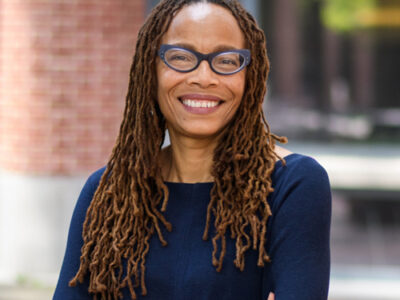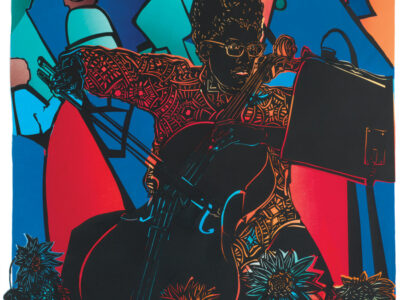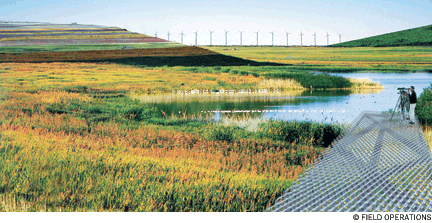
Landscape architects transform sites of blight.
By Virginia Fairweather | Peter Reed G’83 Gr’89 waited nine years to mount the current “Groundswell” exhibition at New York’s Museum of Modern Art. As curator of the museum’s architecture and design department, he wanted to explore the “blurring boundaries between the design professions, new connections with the realm of public policy, and the trend to reinventing abandoned or deteriorated sites for public use.” The delay, caused by MOMA’s move to a site in Queens during its redesign and subsequent reconstruction, turned out to be a blessing in disguise. The show, says Reed, is “even richer and more relevant” than it would have been before.
The exhibition’s subtitle, “Constructing the Contemporary Landscape,” helps to explain the mischievous title, but does not prepare one for the scope, complexity, and—in many cases—the beauty of the reinvented public spaces on display. The sites represented at MOMA are bold transfigurations of spaces once used for other purposes: town centers, industrial or military sites, landfills, and former war zones. All the projects reflect the social and cultural changes and the interaction with the public sphere that have broadened the landscape-architecture profession.
The show has a strong Penn presence. Among the 23 projects selected for display by Reed and his associates, three are by prominent designers associated with the University. One is James Corner, chairman of the Department of Landscape Architecture; his firm, Field Operations, developed a 30-year master plan titled “Fresh Kills Lifescape” to transform the 2,200-acre Fresh Kills landfill on Staten Island into public recreational space. Another is Peter Latz, of Latz und Partners, Kransburg, Germany, who serves as an adjunct professor in the landscape-architecture department. His vast Duisberg Nord plan covers 700 acres in a post-industrial region of Germany, and proposes to convert the contaminated site of a former steel plant to public parkland over a 10-year period. The third is Marion Weiss, an associate professor of architecture and a partner in the New York Firm of Weiss/Manfredi who designed the Olympic Sculpture Park in Seattle. All three won design competitions for their imaginative plans to reinvent these “used” sites.
“Groundswell” amply illustrates the profound departure from the old stereotype of landscape architecture as garden design. Many projects in the show are reinventions of inhospitable and sometimes downright toxic spaces, says Reed, and the shift from already “green” sites to the rejuvenation of manmade sites parallels the change from private to public use. The emphasis on the future is an overarching theme, one that bespeaks optimism, he adds. These designers are looking ahead to unknown future uses and needs at their sites, and trusting to nature’s palliative possibilities. The resulting designs prompted Nicholai Ousouroff, architecture critic for The New York Times, to describe the exhibit as “confronting blight with hope.”
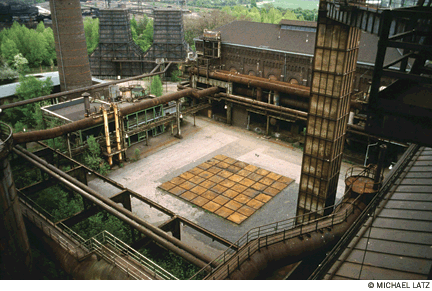
That blighted past figures prominently in the show. The Seattle site was once an oil-storage and -transfer station, and the soils are undergoing remediation, a complex task in the constricted urban setting. Duisberg Nord, where the Thyssen steel works once churned out munitions for the German war effort in World War II, is now Emscher Park (after the once-polluted Emscher River), and the remnants of the steel works have become sculptures and public playgrounds. At Fresh Kills, 53 years of municipal waste underlie the evolving park. There is an especially poignant aspect to this site: the unidentified remains of those killed on 9/11 are interred in one part of what will be a public park. A memorial will mark that area.
Nature is always present in the Groundswell projects, and the plants and trees are not merely decorative. They are working plants, so-called “pioneer” plants that enrich the soil and facilitate new kinds of growth. While the landscape architects in the show designed the plantings, they have also allowed for unpredictability.
Corner, for example, emphasizes that his master plan for Fresh Kills is a “strategy, not a design in any rigid sense,” and his “Lifescape” title recognizes the role that natural processes will play over this 30-year metamorphosis. There is immense uncertainty at the vast site, where mounds of contaminated fill, some 225 feet high, are covered with impenetrable geosynthetic caps. Beneath that barrier, gases may react and groundwater may intrude, and the undulating landscape will change in unknown ways. The design had to be fluid to accommodate the long-term life cycles of certain plants, says Corner, who describes his approach as “time-based, capable of absorbing and reflecting nature’s role.” Over the next decades, the grand master plan calls for multiple structures and playing fields, wetlands, creeks, and wildlife habitats.
Corner’s firm, incidentally, also heads the team selected in a highly publicized design competition for the High Line, an abandoned elevated railway line on the West Side of Manhattan [“Alumni Profiles,” May/June 2004]. The project is in the early stages of design with the architectural firm Diller + Scofidio and does not appear in “Groundswell,” but the concept continues the theme of transforming disused infrastructure into public space.
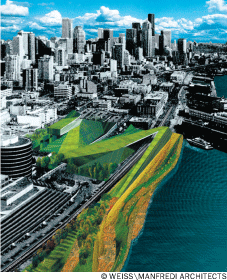
Marion Weiss’ Olympic Sculpture Park in Seattle is one of the show’s most intricate and original works. The dreary eight-acre site along Elliot Bay in downtown Seattle had been home to a fuel-storage and oil-transfer station that left a legacy of pollution. The plan to change it to a public space is highly complex, and the excellent video explains the before-and-after process. To “slow things down,” in Weiss’ words, a 2,200-foot elevated pedestrian path meanders over a highway, a rail line, and the infrastructural backbone of teledata ports, water, and power lines. An art-museum pavilion will anchor the site, though the pièce de résistance for many will be Seattle’s first city beach, at the foot of the path to the Elliot Bay side, where the design includes a new salmon habitat. Ironically, the Olympic Sculpture Park is in an area where, a century ago, a developer leveled an entire city bluff because flat land would be easier to build on and attract investment—an unthinkable approach to land use today.
Latz’s Duisberg Nord, whose depictions of stark industrial remains surrounded by trees, flowers, and children at play dominate the exhibit space, is one of Groundswell’s most evocative displays. Though removing or destroying the abandoned industrial remains at Duisberg would have been economically impossible in any case, Latz says he wanted to “keep the spirit of the existing site, the visible or invisible remembrances, and to challenge the viewer’s senses.” The ore bunkers, blast furnaces, and other structural elements stand as sculptures, some brightly lit in color at night. The catwalks and the formerly polluted canals form pathways through the park. New trees and flowers embrace the ruins, helping to remediate the toxic soil. The result is an extraordinary park—a haunting mix of memory and faith in the healing power of nature.
Latz also conducts design studios at Penn Design, and his studios have taken students to industrial or former industrial sites in Pennsylvania and Europe. Arguably the leading designer in the movement to restore ruined industrial sites, his work includes intense remediation of soil and water as well as the intertwining of plants and park within the abandoned buildings. He speaks eloquently of the necessity of reusing industrial sites: “We can’t discover a new continent as we did in the past. Our density is such that we must intervene with these sites. Politically and socially, there will be more and more of these projects. We must do this.”
Virginia Fairweather writes on architecture and engineering. She is co-author, most recently, of Expressing Structure: The Technology of Large-Scale Buildings.



